Throttle position sensors don't make noise so forget that. Lifters don't get weak. Their operation depends on oil pressure. Valve train noise is usually a result of low oil pressure, a plugged oil feed hole in the side of a lifter, or a camshaft lobe worn so far the lifter can't pump up any more to adjust enough.
There is a tool you might be able to borrow or rent from an auto parts store that borrows them called the "Chassis Ear". It is a set of six microphones, a switch box, and headphones. You clip the microphones to suspect points, then drive around while listening with the headphones. You can move the microphones around to zero in on the source of the noise. Be aware that many mechanics have never seen or even heard of this tool. Suspension and alignment mechanics use it to find rattles, squeaks, and other noises.
A crack in an exhaust manifold or a loose connection between the manifold and exhaust pipe can make a clicking noise but you'll usually only hear it when under load / accelerating. You can also hear it while a helper holds the brakes and accelerates at the same time.
The timing chain can be worn excessively and rattle against the housing but that isn't affected by engine load. You'll usually hear that at idle too, but most importantly, that causes the camshaft timing to bounce around. You may experience surging. That was more common on older engines that used a pickup coil in the distributor for ignition timing. You didn't say which engine you have. If it's a V-8 or V-6, it has a timing chain. The 4 cylinder engine uses a timing belt. You can remove the distributor cap, then watch how soon the rotor starts to turn when you turn the crankshaft back and forth. If the timing chain is sloppy, you'll be able to turn the crank a few degrees before the rotor starts to turn. You need to observe that with the crank in a number of different positions because there is always a cam lobe pushing on the camshaft from the pressure of the valve springs. As you continue to slowly turn the crankshaft, you may see the rotor stop turning, then resume turning, as you turn the crank steadily one way.
Thursday, November 14th, 2013 AT 11:41 PM



